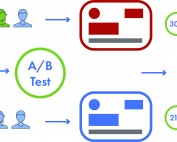What is digital advertising?
Digital advertising refers to paid advertisements placed across multiple digital media platforms like search engines, websites, applications, and online directories. Ever see a social media advertisement while scrolling through Facebook and decided to click the link? That’s digital advertising at work.
There are many formats of digital advertising that marketers can use to reach potential customers, each with their own unique attributes. It’s important to note, however, that digital advertising is not the same as earned or owned media search efforts such as Search Engine Optimization or organic social media marketing.
The Digital Advertising Dictionary
Digital advertising is a sophisticated industry all its own. There are skilled professionals whose sole jobs are to create and manage these types of campaigns, however there are benefits to learning the basics. Here are some important terms to understand when learning more about digital advertising, including:
- CPM (Cost per Mille) – the cost per every thousand impressions.
- CPC (Cost per Click) – the cost per click-through.
- CTR (Click Thru Rate) – the ratio of users who click on an ad to the number of total users who view the ad.
- PPC (Pay per Click) – payment for an advertising campaign per each click through. A common format for search ads.
Search Engine Marketing (SEM) or ‘Pay-Per-Click’ Search Ads
SEM is the most common form of digital advertising. These text-based ads are designed to move your website higher in the search engine results page (SERP) based on keywords entered by users. SEM ads appear at the top or sides of search engines such as Google, Yahoo, or Bing. These paid campaigns often work in tandem with unpaid SEO strategy.
Display Ads
Display ads are visual ads that appear on third-party websites or applications. They may be delivered as static graphics like banners and sidebar images, floating banners that move across the screen, popup ads, or even videos. Some vendors, like the Google Display Network, allow for demographic, geographic, and behavioral targeting to be applied to the campaign. Imagine these as virtual billboards that appear along your journey through the digital highway.
Mobile Ads
Mobile ads are a form of display ads optimized for mobile devices such as smartphones and tablets. As customers spend large amounts of time on their smartphones, mobile ad campaigns are growing in popularity and effectiveness. The geo-targeting abilities of mobile campaigns allow marketers to serve location-based ads directly to a local audience.
SMS text ads are another form of mobile advertising. Text ads have the unique ability to reach audiences at a very specific time, making the format useful for time sensitive notifications.
Social Media Ads
More brands are turning to platforms like Facebook, Instagram, and Twitter to interact with targeted audiences based on a variety of demographics. For instance, Facebook’s targeting options include age, interests, geography, education and more.
Ad formats vary by platform but may include anything from simple banner images to auto-play videos. When starting an initial social media advertising campaign, brands should look at which channels are performing well organically and start there.
Retargeting Ads
Retargeting (also known as remarketing) ads are designed to redirect potential customers back to your website. By keeping track of people who visit your website, retargeting ads ‘follow’ potential customers around the internet with the goal of redirecting them back to your website.
Video Ads
Video ads are particularly effective at grabbing the attention of oversaturated viewers. Ads come in many styles and lengths. Instream ads appear in the beginning, middle, or end of the video content a user is already viewing and out-stream ads appear on their own, similar to display ads. Popular channels for video ads include Youtube, Vimeo, Hulu, and Facebook.
Why go digital?
Data, data, and more data! There are plenty of good reasons to go digital, but the abundance of real time data is perhaps the most compelling. Analyzing this data allows marketers to quickly refine strategies and build more effective campaigns.
Too much?
It can be a challenge for marketers and businesses to keep up to date with ever-evolving digital channels and the analytics that follow. If your team needs support creating and executing a digital advertising strategy, Contact us for assistance.









